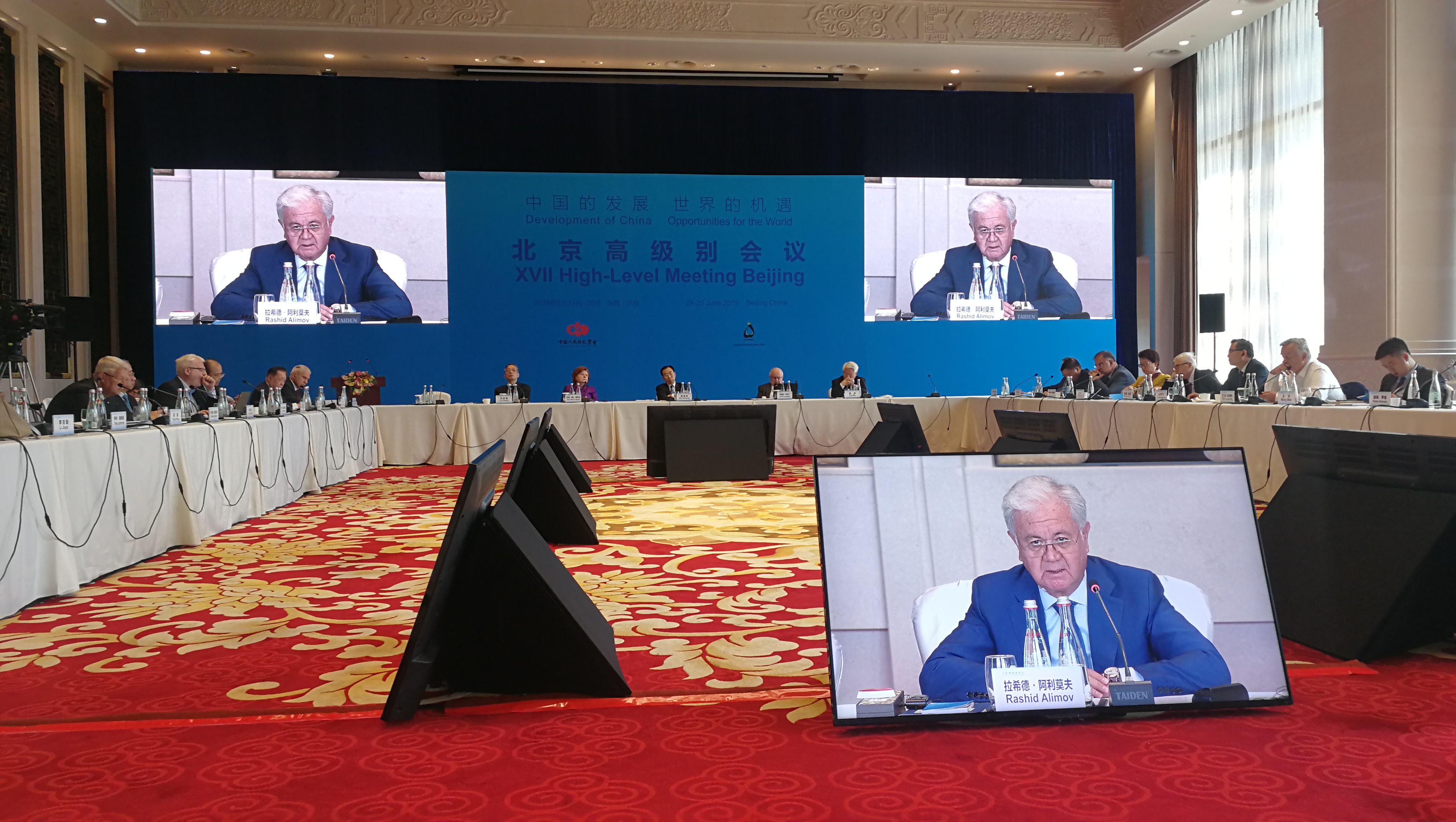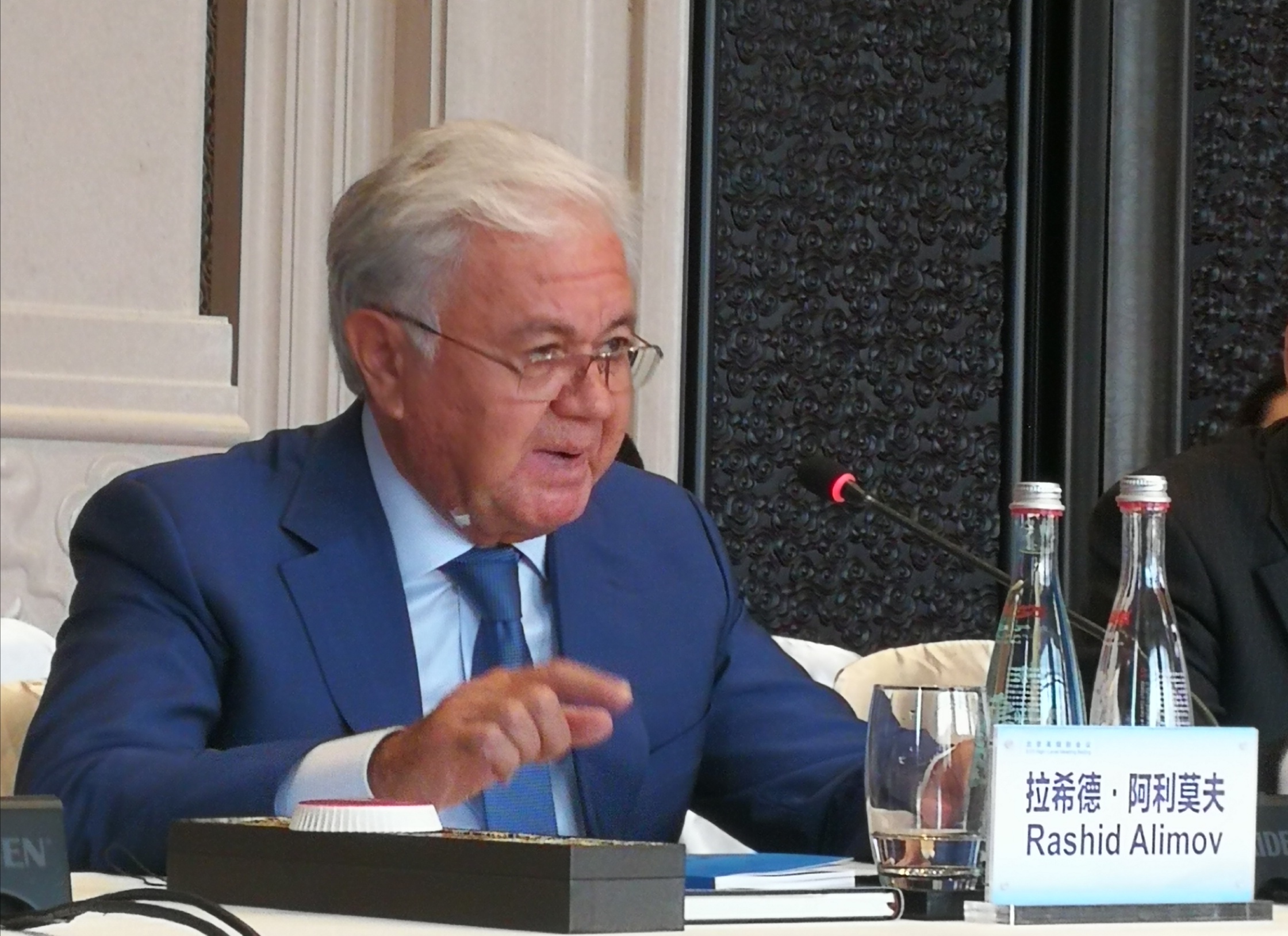
On June 24th, the 17th High-Level Meeting in Beijing jointly hosted by Chinese People’s Institute of Foreign Affairs and Nizami Ganjavi International Center was held in Beijing, China. The meeting themed on “Development of China, Opportunities for the World” gathered political leaders, scholars and experts from all over the world. Mr. Rashid Alimov, Doctor of Political Science, SCO Secretary General (2016-2018), and Senior Fellow of Taihe Institute attended the meeting and gave a keynote speech regarding the Belt and Road Initiative. Taihe has been working closely with the two organizers to promote mutual understanding among different civilizations and facilitate international dialogues. Below is the full text of the speech of Mr. Rashid Alimov.

Dear Mr. Chairman,
Dear Colleagues,
First of all, let me express my sincere appreciation to the organizers for the invitation to take part in the work of the Forum. Two months ago, the second High Level International Conference “One Belt, One Road” was held here in Beijing. It was a great honor for me personally to be one of the delegates to the conference, which has truly become a global event.
I recalled that the heads of state and governments, as well as guests from 150 countries and 92 international organizations, including the UN Secretary-General and the Director of the International Monetary Fund, took part in the conference. There was an in-depth exchange of views not only on the achievements of the “Belt and Road” over the past five years, but also on the issues and prospects of the Initiative.
It is obvious that the “Belt and Road” opened the “second wind” for the development of the global economy, created additional conditions for the growth of the global economy, and the strengthening of international trade and economic cooperation. Over the past five years, the size of direct investment by Chinese enterprises in the countries involved in the Initiative’s orbit has reached $ 100 billion; their trade with China reached six trillion dollars, and the average annual increase was by 4%.
Strategic investments in the reconstruction of existing and creation of new trade routes, transport, and economic corridors linking the countries of Asia, Europe and Africa created additional conditions for the development of trade relations between them and China. Among the first benefits felt by the Central Asian states that do not have access to the sea. Over the past 10 years, with the participation of Chinese companies in these countries, about three thousand enterprises have been built.
The initiative makes an important contribution to improving the architecture of global economic governance. An important role in this process is assigned to new financial institutions - the Asian Infrastructure Investment Bank and the Silk Road Fund. Their total capital is 140 billion dollars.
The number of implemented and launched joint projects in the sphere of economics and trade, transport and communications, science and education, culture and art is growing. Each of them opens up broad prospects for countries and international organizations, for all who are involved in the orbit of the Initiative. The initiative stimulates the intensification of interaction between such multilateral mechanisms as the SCO, China-ASEAN, APEC, CICA, the Forum of Chinese-Arab Cooperation and others.
The main point: participation in the joint implementation of the Initiative allows countries to match national interests - with the interests of the regions; own national development strategies - with the United Nations Sustainable Development Goals - 2030. In essence, the “Belt and Road” is a new form of global international cooperation based on an equal and mutually respectful dialogue. This is especially important in our time, when the entire system of international relations, including trade and economy, is undergoing a period of fundamental changes.
While the process of economic globalization is facing an increase in unilateral protectionist measures, trade wars and other challenges in international trade, China is taking steps to ensure greater openness in its ever-expanding market. Here, first of all, it is worth noting the updated Foreign Investment Law and the International Import Expo in Shanghai; reduction of tariff rates; in general, a qualitative improvement in the business environment; as well as the construction of a “green economy” and joint efforts in the field of environmental protection,
The “Belt and Road” initiative is, in my deep conviction, an inter-civilizational megaproject of the third millennium. As China’s Chairman Xi Jinping noted, “civilizations should not collide with each other,” on the contrary, they should strive for equal, diversified and diverse exchange “without coercion and imposition.” At the same time, as Henry Kissinger accurately noted, “China is not engaged in converting others to its faith.”
Modern China continues to undergo wide and profound changes, which are aimed not only at solving domestic problems, but also at increasing China’s contribution to strengthening international cooperation. The “Belt and Road” Initiative is a logical continuation of the successful reform and opening up policy of China, meeting the realities of the 21st century.
Forty years ago, China took the first steps to get out of isolation and foster international cooperation. Foreign investment was sporadic, and Chinese companies rarely carried out projects abroad. Internal socio-economic problems hampered the development of China: 90% of the population lived below the poverty line. China's GDP at the beginning of the reforms was a modest amount of $ 150 billion.
The reform and opening up policy has awakened the enormous internal resources of Chinese society. The Chinese economy in the 90s grew at a rate not lower than 7% per year, and in the first decade of the 21st century, this figure was over 10%. For four decades, China’s GDP has increased more than 88 times and in 2018 approached the mark of 13 and a half trillion dollars. At the same time, the share of the population living below the poverty line during this period decreased to 0.12% (16.6 million).
The rapid economic growth of China and the peaceful development of the country contributed to its acquisition of a new status - a global financial and economic power. This opened up opportunities for assisting and supporting the development of the economies of most countries in Asia and Africa, Latin America, and Eastern and Central Europe. This assistance goes both bilaterally and through the UN system.
The share of China's contributions to the UN regular budget in 2019 increased from the previous 8% to 12%, to the peacekeeping operations budget from 10% to 15%. China ranks second after the United States in terms of peacekeeping contributions; at the same time, with its military contingents it takes part in 9 of 14 operations. 20 years ago it was impossible to imagine such a picture.
The success of reforms and opening up in a short time turned China into the center of the most advanced scientific and intellectual thought. A strong economy and science have accelerated China’s space exploration, as well as a new generation of technologies. In the face of the company Huawei and technology 5G China has brought the future closer.
The prestige of a Chinese university diploma has sharply increased, and the number of people studying Chinese in the world has almost become equal to the number of people studying English. It is significant that in 2018 about half a million students from 196 countries and territories studied in universities in China: this is twenty times more than in 1998. Graduates of Chinese universities are actively involved in business projects. In 2018 Chinese incubators alone, 620,000 startups were launched, which registered 106,000 patents applications processed.
Accession to the WTO in December 2001 benefited China and the entire world economic system. The 29th Summer Olympics, triumphantly held in Beijing in 2008, were acknowledged by the international community for the social stability, social progress and economic prosperity of China.
These two events, one might say, symbolized the irreversibility of the course towards the implementation of reforms and openness. In this context, we can safely talk about the irreversibility of the implementation of the “One Belt, One Road ” Initiative.
Obviously, as it advances, the Initiative will face a variety of traditional and non-traditional challenges. The Initiative has not only supporters, but also critics. New invariably encountered with obstacles. That is why it is so important to strengthen international cooperation, jointly respond to global challenges, jointly develop a common future. "Belt and Road" Invites the world to this.
Thank you for attention!
—————————————————————
FOCUS ON CONTEMPORARY NEEDS.
Should you have any questions, please contact us at public@taiheglobal.org